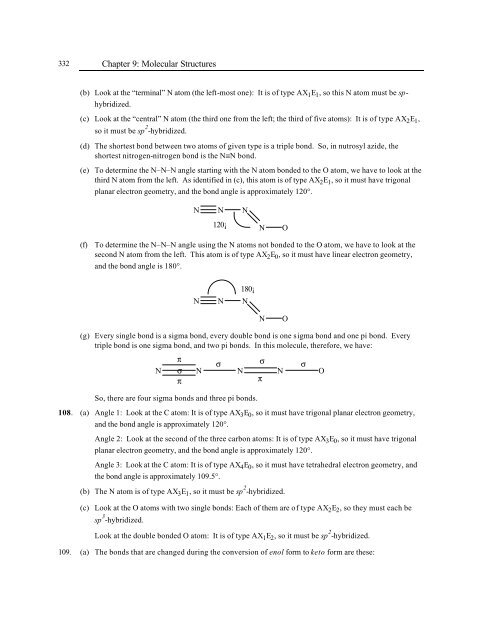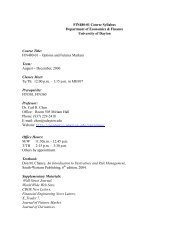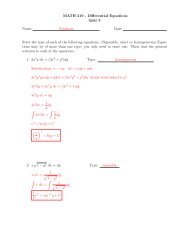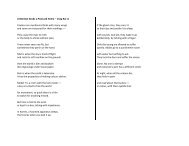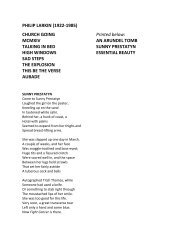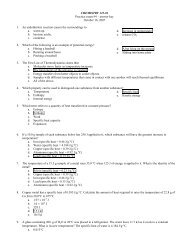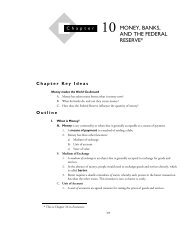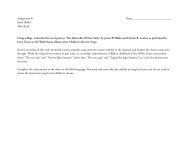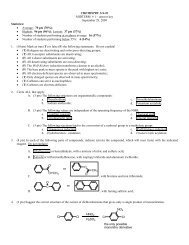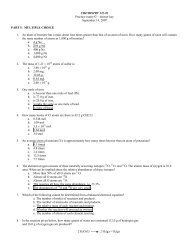Chapter 9 - University of Dayton Academic Webserver
Chapter 9 - University of Dayton Academic Webserver
Chapter 9 - University of Dayton Academic Webserver
You also want an ePaper? Increase the reach of your titles
YUMPU automatically turns print PDFs into web optimized ePapers that Google loves.
332<br />
<strong>Chapter</strong> 9: Molecular Structures<br />
(b) Look at the “terminal” N atom (the left-most one): It is <strong>of</strong> type AX 1E 1, so this N atom must be sp-<br />
hybridized.<br />
(c) Look at the “central” N atom (the third one from the left; the third <strong>of</strong> five atoms): It is <strong>of</strong> type AX 2E 1,<br />
so it must be sp 2 -hybridized.<br />
(d) The shortest bond between two atoms <strong>of</strong> given type is a triple bond. So, in nutrosyl azide, the<br />
shortest nitrogen-nitrogen bond is the N≡N bond.<br />
(e) To determine the N–N–N angle starting with the N atom bonded to the O atom, we have to look at the<br />
third N atom from the left. As identified in (c), this atom is <strong>of</strong> type AX 2E 1, so it must have trigonal<br />
planar electron geometry, and the bond angle is approximately 120°.<br />
N<br />
N N<br />
120¡<br />
N O<br />
(f) To determine the N–N–N angle using the N atoms not bonded to the O atom, we have to look at the<br />
second N atom from the left. This atom is <strong>of</strong> type AX 2E 0, so it must have linear electron geometry,<br />
and the bond angle is 180°.<br />
N<br />
180¡<br />
N N<br />
N O<br />
(g) Every single bond is a sigma bond, every double bond is one sigma bond and one pi bond. Every<br />
triple bond is one sigma bond, and two pi bonds. In this molecule, therefore, we have:<br />
π<br />
N σ<br />
π<br />
So, there are four sigma bonds and three pi bonds.<br />
σ σ σ<br />
N N N O<br />
π<br />
108. (a) Angle 1: Look at the C atom: It is <strong>of</strong> type AX 3E 0, so it must have trigonal planar electron geometry,<br />
and the bond angle is approximately 120°.<br />
Angle 2: Look at the second <strong>of</strong> the three carbon atoms: It is <strong>of</strong> type AX 3E 0, so it must have trigonal<br />
planar electron geometry, and the bond angle is approximately 120°.<br />
Angle 3: Look at the C atom: It is <strong>of</strong> type AX 4E 0, so it must have tetrahedral electron geometry, and<br />
the bond angle is approximately 109.5°.<br />
(b) The N atom is <strong>of</strong> type AX 3E 1, so it must be sp 2 -hybridized.<br />
(c) Look at the O atoms with two single bonds: Each <strong>of</strong> them are <strong>of</strong> type AX 2E 2, so they must each be<br />
sp 3 -hybridized.<br />
Look at the double bonded O atom: It is <strong>of</strong> type AX 1E 2, so it must be sp 2 -hybridized.<br />
109. (a) The bonds that are changed during the conversion <strong>of</strong> enol form to keto form are these:


